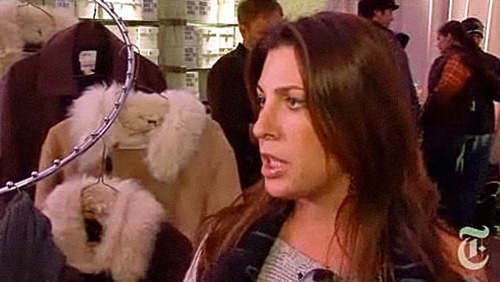In today’s New York Times, Manohla Dargis writes:
For almost as long as it’s been in existence, the Sundance Film Festival has fended off criticism that it has gone Hollywood. […]
But let us not be (entirely) cynical. For all its problems, the festival remains one of the most important in the world and the foremost launching pad for American independents.
Both parts of that last sentence are arguable, but if Sundance is (or has ever been) one of the most important film festivals in the world, I hope it’s because it retains some power to launch American films, “independent” or otherwise, into the media and consumer marketplace — and not just because it’s a big party in an upscale ski resort town.
Ironically (intentionally?) embedded in the above article, however, was this (un-embeddable) Carpetbagger video about the exclusive swagfest — the “gifting suites” to which persons of predetermined celebrity are invited and… “gifted” by corporations and boutique merchants. You may want to throw up (I did), but the shameless decadence is something to see. (Does the festival officially cooperate with these ventures? How do they determine who’s attending and who’s on their lists?)
Meanwhile, Wesley Morris in the Boston Globe says he’s never heard more griping about the actual movies being shown:
PARK CITY, Utah – What on earth is happening? In all my years attending the Sundance Film Festival, I’ve never heard more grumbling. No one likes anything. (OK, not exactly true – I’m a fan of “Please Give,” “I Am Love,” “Night Watches Us,” and the lottery documentary “Lucky,” and I’ve heard great things about the docs “Catfish” and “Exit Through the Gift Shop.”) Still, one distributor joked at a cocktail reception that this year the dramatic jury should hand out a prize for the worst film. Everybody has one.
I’m wondering if this might turn out to be a sign of health. Can Sundance’s reputation survive a move away from the Hollywood-friendly “Sundance movies” that have been its bread and butter for the last 20 years, since the studios pounced on the festival after “sex, lies, and videotape” put it on the map? What does it mean that, this year, low-budget movies have their own special sidebar called “Next”? Manohla writes:
The idea that Sundance needs to create a sidebar for movies made on the cheap might sound paradoxical if not ridiculous, as was noted by a filmmaker, Daniel Harris, writing on the blog for the rival Slamdance Film Festival (slamdance.com), which takes place at the same time in Park City. “To sidebar low-budget films for their lack of finance makes them look like Special Olympics kids competing in the big show,” Mr. Harris wrote, before going on to encourage filmmakers to boycott the Sundance sidebar in question. As a matter of fact, the Next section did not register as an afterthought: audiences and distributors gravitate to selections with famous names, but as the mostly full theaters show, attention and love — if not always the large deals and press — are lavished on no-name titles too.
The one thing almost everyone can agree on — and this has long been true of almost any eclectic film festival — is that your chances of seeing a worthwhile film are better among documentaries than fiction features. The Sundance titles I keep hearing about — and am most excited to see — are all docs: “Catfish,” “Restrepo,” “The Tillman Story,” “Gasland,” “12th & Delaware,” “Smash His Camera”…
Marshall Fine reports:
Buzz? Buzz is meaningless, the efforts of pundits to spin public opinion. There was lots of talk about the film “Blue Valentine” before Sundance, based on a cast that was headed by Ryan Gosling and Michelle Williams. But after people saw it, suddenly it no longer seemed like the hot-out-of-Sundance title it was touted to be.
By contrast, I hadn’t heard a word about “Catfish” before the film played, other than from the publicist who was urging me to see it. But 24 hours later, it seemed to be the one film everyone either loved or was dying to see.
I’m also looking forward to “The Runaways” (which reminds me to re-watch Lou Adler’s 1982 “Ladies and Gentlemen, the Fabulous Stains,” barely released in theaters and finally made available on DVD in 2008 — and which I haven’t seen since I booked it into a little Seattle art house/coffeehouse in the early 1980s). It was a hot ticket at Sundance, where the lines were long to see Kristen Stewart and Dakota Fanning perform “Cherry Bomb,” but I have to wonder: Will there be similar lines when the movie opens theatrically in March? Or was this just another one of those fleeting festival phenomena that evaporate at lower, less hype-sensitive elevations?











